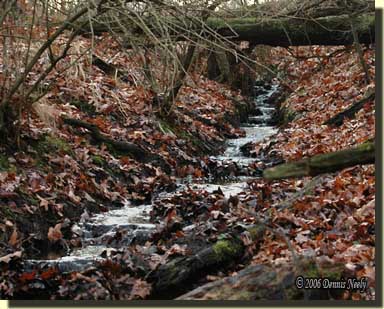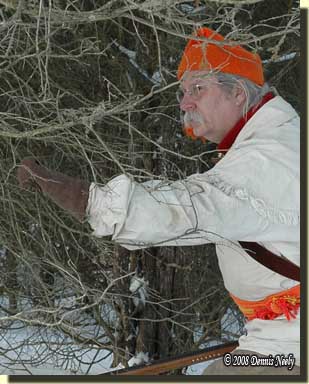Water gurgled in the gravelly cut. Two solid days of heavy, November rain filled the swamps. The thicker of the two, the south swamp, appeared higher than the sparser swale hole to the north. A thigh-deep cut crossed the mounded base of Fox Hill, connecting the two, and when the south swamp’s water grew deep, it trickled through the cut and out into the other.
 On that afternoon, on Thanksgiving Day, in the Year of our Lord, 1794, the constant gurgling tweaked my curiosity. After looking about, I rose, checked the prime and cradled the Northwest gun. A dozen or so footfalls later I peered over the bank. The little creek’s total distance was all of twenty paces. To the right, a few trade gun lengths from the delta, a miniature rapids not three moccasins wide rolled pebbles northward. Yellow sand spilled over black silt as the water fanned out, then pooled.
On that afternoon, on Thanksgiving Day, in the Year of our Lord, 1794, the constant gurgling tweaked my curiosity. After looking about, I rose, checked the prime and cradled the Northwest gun. A dozen or so footfalls later I peered over the bank. The little creek’s total distance was all of twenty paces. To the right, a few trade gun lengths from the delta, a miniature rapids not three moccasins wide rolled pebbles northward. Yellow sand spilled over black silt as the water fanned out, then pooled.
The air was cold, crisp and smelled of impending snow. Wet oak leaves perfumed the forest. My buffalo-hide moccasins stalked the three red oak trunks that shared a common root. The rolled-and-bound trade blanket, tucked to the back of the cleared-out nest, looked inviting. Once again I sat on the bedroll and leaned back against the middle tree, half-hidden in the little cove created by the trunks.
Comfortable, I sat motionless; only my eyes moved, surveying the various deer trails. A trail followed the base of each side of Fox Hill. Two crossed over, fifty or so paces uphill. Two approached from the east, and several led from the south swamp’s tangle, converging back to my left. Most afternoons, at least in cold weather, whitetails on their way to an evening frolic choose the north-most path, which veers past the three oaks, a good fifteen paces distant. A gentle breeze pushed out of the northwest, turning the oaks into a prime ambush site.
About forty minutes before last light, a fast-walking doe with its tail curled over its back appeared on the path at the base of the south face. She angled northeast, paused broadside on the hill’s crest, then continued on. I began to squint a good ways before she reached the cut. In a few moments, she slowed a bit as she passed my lair. I thought of the sweet juice running from a fresh-bit apple; she scampered on and disappeared.
A light snow began to fall. Not long after an older doe and her two yearlings meandered along the north, hill-base trail. The three browsed their way east. Twenty minutes later they passed the three oaks, but they never hesitated or displayed any inkling of concern. My eyelids felt tired and dry from squinting for so long.
With great reluctance, I soon found it necessary to get to my feet. I slung the bedroll over my shoulder and snuggled the Northwest gun’s lock up into the shelter of my right arm pit. I supposed enough light remained to return to the wagon road without stumbling over unseen roots and branches in the dark. I offered a prayer of thanks for a bountiful day, even though I trudged homeward empty handed.
A Lot of Soul Searching…
Thirty-plus seasons ago, when I first chose the path to yesteryear, I spotted a group of does bedded near the cut at the base of Fox Hill. That was during mid-November. Not wishing to disturb them, I jotted a mental note and continued on with that day’s still-hunt. The same scenario played out several times over the next couple of years, and each time the doe or does bedded with their rumps to the prevailing wind, facing uphill. The only time a doe faced east was when she was with a larger group.
In February, at the Michigan Deer and Turkey Expo, a gentleman who is also a traditional black powder hunter spent a fair amount of time at our camp display. As one might expect, the discussions wandered hinter and yon. We talked about using natural cover instead of tree stands and “people boxes,” as Tami calls them. The topic shifted, and the question was raised: “How do you pick your deer stand locations?”
Well, the eyebrows shot up and the mouth came open when I answered: “A lot of the times, I let the deer pick them.” I was dead serious, although I must admit that response sounds a bit smart-alecky.
For me, one of the great learning experiences of participating in outdoor shows is the guest questions. Clarence Moore, my high school math teacher, taught me that “no question is unimportant,” and you hear everything, but always asked in earnest. Yet, sometimes the simplest query requires deep thought and probing introspection.
At my very first Woods-N-Water News Outdoor Weekend in Imlay City, I hemmed and hawed when asked “How do you pick your deer stand locations?” The soul searching lasted well into the December muzzleloading deer season, then I realized that one of the answers was “I let the deer pick them…”
Learning in the Wilderness Classroom
The whole purpose behind the notion of viewing the glade as a wilderness classroom is learning. Eighteenth-century learning takes hard work, demands careful observation and requires a change in one’s perspective with respect to the outdoor endeavors in general. A keen sense of kid-like curiosity helps, too.
On a cold, snowy December morning, I sat with my back to a wild cherry tree, a favorite deer hunting stand when the wind is out of the south. I pondered that tree’s girth, and how it had grown over the last twenty or so years, then I recalled the first time I sat there.
 It was mid-November. I was still-hunting the crest of a ridge when I spied a mature doe bedded a pace or two from the cherry—sixty paces distant. A pleasant breeze pushed soft from the south. The air carried the sweet smell of drying corn. The sun was almost touching the western tree line. As I so often do, I knelt to study the situation, to begin a serendipitous lesson. My legs cramped. I rolled back on my rump and sat cross-legged in the middle of a doe trail.
It was mid-November. I was still-hunting the crest of a ridge when I spied a mature doe bedded a pace or two from the cherry—sixty paces distant. A pleasant breeze pushed soft from the south. The air carried the sweet smell of drying corn. The sun was almost touching the western tree line. As I so often do, I knelt to study the situation, to begin a serendipitous lesson. My legs cramped. I rolled back on my rump and sat cross-legged in the middle of a doe trail.
I don’t remember how long I sat, but it was a while. The whole time I watched the doe, studied her movements and mannerisms—hard work and observation. Before sunset, the doe got up, stretched and shook. She walked down the hill’s steep north face, struck a trail and headed west. I got to my feet, stretched, but didn’t shake.
When the still-hunt reached her bed, I stood for the longest time, just trying to determine why she chose that spot to bed down. Curiosity drove me to look further, to delve deeper. I dropped to my knees and surveyed all about. That spot afforded a commanding view of the hillside and a half dozen trails, in essence, the four points of the compass. I began to understand the woodland wisdom behind her choice.
As before, when my legs started cramping I sat in her bed. With only a few minutes of shootable light left, I glimpsed movement to the west. A broken-rack six-point, a scrawny first-year buck, appeared and headed in my general direction. I chose not to shoot, but rather to study and learn.
And here is a prime example of the need for a change in perspective. The vast majority of today’s hunters would have taken the first shot available, but I did not. I observed that buck until the light grew dim. All the while, he had no inkling death lurked so close. Although I could not shoot, the real prize was discovering the fine eight-point buck that followed in the little buck’s wake. Had I shot the first buck, I would not have known about the second one—a valuable lesson learned.
A few days later I returned to that spot and sat with my back to the cherry tree, and needless to say, that bed beside the wild cherry became a favorite lair. The same holds true for the three oaks at the base of Fox Hill, and a host of other hiding places—all picked by bedded does.
Do what the whitetails do, be safe and may God bless you.



2 Responses to “I Let the Deer Pick Them…”